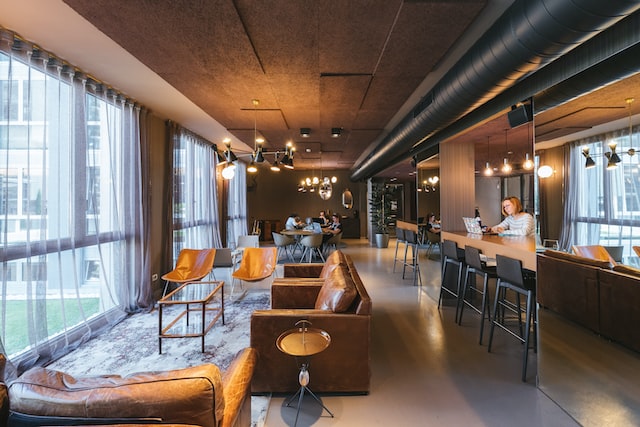 The events of 2020 caused substantial disruption to the commercial real estate sector. The office space market in particular was heavily impacted by lockdowns and other pandemic-related restrictions, still struggling to get back to pre-pandemic occupancy levels more than two years on.
The events of 2020 caused substantial disruption to the commercial real estate sector. The office space market in particular was heavily impacted by lockdowns and other pandemic-related restrictions, still struggling to get back to pre-pandemic occupancy levels more than two years on.
Prior to the pandemic, non-traditional working models had already gained some prominence. Having now emerged on the other side into a ‘new world of work’, the adoption of flexible workspaces has accelerated interest in both hybrid and remote working models. An ever-increasing number of businesses are now finding themselves entering the flexible workspace market, increasing uptake in tandem with society-wide changes towards remote working, heightened mobility, and the overhauling of workspace design.
Although demand and activity levels for traditional offices are still lagging behind pre-pandemic expectations, opportunities for growth are emerging in other parts of the office space industry. In this article, we discuss the increasing demand for flexible office solutions seen across the UK, and the impact of this trend on wider CRE and labour markets.

2022 Flexible Office Space Market – 8 Key Points
- Hybrid working policies are the primary driver for increased flexible workspace demand
- Companies are utilising coworking options and serviced offices at record levels
- In the last year, demand for flexible office space is up 22%
- Cities like Leeds, Manchester and Birmingham are the primary flexible markets in the UK
- In 2022, Central London has experienced notable recovery in demand and occupancy of flexible offices
- London property developer GPE intends to increase its flex portfolio stake as a proportion of their holdings from 13% to 25% by 2027
- CBRE Group has acquired 40% of coworking provider Industrious
- The flexible market is growing, with the number of spaces in the UK expected to double by 2026, to 10% of total office space

Demand for Flexible Workspace is Creating Tight Market Conditions
A key takeaway from Jones Lang LaSalle’s late 2021 report into global flex space found that upwards of 40% of workspace occupiers expected their utilisation of flex spaces to increase as part of their ongoing post-pandemic operational strategy.
Demand for flexible office space had also been growing steadily for a few years up until 2020. In fact, take up levels reached record highs in 2018 and 2019, both in London and regional markets.
Casting our eyes back to when the pandemic hit, however, growth became stunted – as many providers placed expansion plans on hold due to low occupancy rates. At the height of the pandemic, the flexible sector was among the most vulnerable of all commercial real estate submarkets. This was largely due to the nature of the flexible model, which failed to give providers the security that came with the long-term agreements seen in more traditional leases.
The uncertainty around the future of flexible office space began to ease after many businesses began to gradually and tentatively return to physical office environments. Beginning in earnest in mid-2021, the return-to-work trend served to bolster flex providers’ balance sheets – as occupiers began to trickle in and agreements were signed.
Changes to post-pandemic office occupancy numbers and the mass adoption of hybrid working arrangements also worked in the favour of these property types, driving up demand as businesses noted the cost effectiveness of flexible workspace. The definition of the ‘perfect office space’ had changed for a lot of employers. Whereas in the past, flexibility was a nice perk to sweeten the pot, it quickly became apparent that flexible office space was seen as a must-have moving forward.
Continued growth has been somewhat limited by market inability to accommodate all requests, particularly those that require bespoke solutions and highly sought-after amenities – such as breakout space, wellness facilities, and fibre internet. As more and more companies switch to hybrid working models, an observable trend we’re starting to see appear in certain locations is an imbalance between supply and demand. This imbalance, if left unanswered, could potentially lead to a shortage of flexible office space or hefty upfront costs for those looking to enter the market.

Narrowing the Focus to Coworking Space
Workspaces earmarked solely for coworking haven’t seen as much growth or success as the more nimble, flexible solutions. Coworking juggernaut WeWork has had to reconfigure, offloading 1.1 billion USD in workspace product, reducing operational expenses by almost half a billion USD, and exiting over 100 underperforming markets to remain competitive.
The spaces that seem to be finding the most success are those that combine coworking and flexible space – with divided floor plans and modular furniture to accommodate multiple usage types. This more successful approach follows along with the trends observed in the wider CRE industry, where space usage is continuing to be optimised by companies with smaller and variable physical footprints, resulting in providers gearing their offerings to best suit this demand.
The most successful coworking spaces observed have been those that place an increased emphasis on exciting and humanistic decor, encouraging people to attend physically instead of working from home. Highly successful operators in the submarket have achieved this by generating a sense of community within their offerings, hosting regular networking events, providing exclusive membership benefits, as well as the ever-important inclusion of top-tier amenities.

UK Cities Leading the Charge for Flexible Office Space
Although demand for flexible office space has been seen as a global trend, there were some notable UK-specific differences seen upon emergence out of the pandemic. Growth in demand earlier in 2022 was mostly evident in the regional markets of Cambridge, Manchester, Birmingham, Leeds, and Glasgow. Currently, though, demand has increased somewhat in major metropolitan centres of the aforementioned cities, as well as Central and Greater London.
The late arrival of demand in major city centres is likely due to the growing ability of inner-city flexible office space providers to capture the attention of the market. In addition, the increasing success of these inner-city spaces could be a sign of wider shifts in the labour market, with coworking seen to be a more desirable option for businesses of all shapes and sizes. Sole operators and smaller-scale businesses, who were either working from home or leasing expensive private spaces, were definitely drawn to the flexibility provided by coworking. In a similar vein, large businesses with unnecessarily large inner-city workspaces saw the appeal of streamlining their office footprints towards flex, potentially even coinciding with the adoption of hybrid working models.
Manchester
In Manchester, large corporates like HSBC and Deloitte led flexible office space take-up figures throughout 2021, choosing this arrangement over long-term leases. It was also observed that smaller companies, and those going through growth or transitional phases, were using flex space as a stepping stone to something more permanent. This trend has continued to be visible in the first half of 2022, further signalling the viability of flexible workspace moving forward.
Birmingham
Property consultancy Cushman and Wakefield expect Birmingham to continue to establish itself as a flexible workspace hotspot in the coming years. Prior to 2020, Birmingham was already considered an emerging flex hub, so the West Midlands city seems well positioned to absorb the continued growing demand. While many other UK cities have seen their flexible space prices decrease by as much as 20% since the highs of mid-2020, Birmingham’s price fluctuations have been notably shallower, signalling its continued viability as a location of choice for flexible space providers.
The Limitations of Flexible Office Growth in Regional Markets
Despite the success of the markets mentioned above, these regional hubs are more exposed to potential shortages than London, which, prior to the pandemic, was the most mature flexible office space market in Europe. By contrast, fast-growing regional markets will need to significantly expand their supply pipeline if demand continues to grow strongly.
This potential scenario opens up a range of opportunities for flex space operators looking to expand their presence and capitalise on current appetite for these office assets. Looking ahead, we can expect flex space to become increasingly “mainstream” – as barriers to entry continue to erode. However, currently, the regional flexible office space market is a long way from maturity, largely due to the lack of growth and innovation seen by the limited number of serious providers who control most local regional supply.

Looking Ahead at the Future of Flexible Workspace
If independent flexible space operators seize the opportunities that lie ahead, the UK working landscape could significantly evolve, both in London and other UK cities. The opportunities aren’t limited to existing operators: in fact, many commercial landlords are repurposing their grey space, following along with the flex model. If the large-scale transition away from traditional office space is generally well managed, this can propel the flex office market even further, satisfying burgeoning demand.
As global inflation continues to show no signs of stopping, and the potential for recessions lingers in many leading markets, expect to see levels of self-employment increase. Alongside this growth in sole operators is the rise of location independent workers, something which serves to only increase the demand for flexible space further.
Traditional office space, the exorbitant financial outlays for investors, and daunting lease demands for occupiers, are becoming increasingly obsolete as a new generation of workers demand flexibility. It’s also abundantly clear that the transition towards flex has been accelerated by the lingering consequences of the pandemic, and the ongoing economic uncertainty associated with it. Office space providers and investors, therefore, need to understand this new market in order to continue to gain a good return on their assets and their investments.
Looking for more articles?
You can visit the links below to find more workplace insights:
How Long is Maternity Leave in the UK? A Full Guide
10 Common Employee Misconceptions in the Workplace and How to Avoid Them
5 Things That UK Employees Want in an Office Environment
Average Office Worker Salary UK: How Does Your Job Stack Up?
Top Ten Industries in the UK
The Step-by-Step Ultimate Office Move Checklist for 2022

